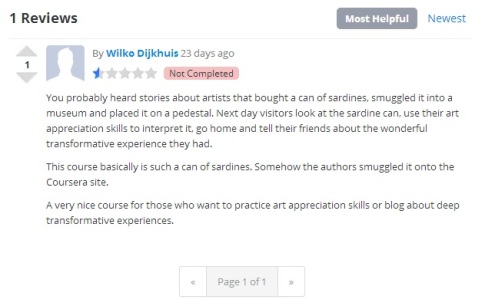As we end the final week of EDCMOOC – a week devoted to the final assignment and in which my teaching role was perhaps pushed further to the ‘side-lines’ – I find myself lured into considering the kind of things we might have achieved on this course. The following comment, from CourseTalk, has given me much to think about in this respect:
While, as I have made clear in previous posts, I welcome criticism, the above observation has become particularly cherished. Despite my genuine respect for Wilko’s concerns, the analogy is, for me, undoubtedly complimentary. From the outset of planning this course, we have been very much interested in challenging the boundaries of what is possible with an ‘online’ course, and this description seems to encapsulate these attempts very satisfactorily indeed. I use the word ‘challenging’ here intentionally, aware of its vagueness. ‘Subversion’ might be another term appropriate to our strategy, although I wouldn’t necessarily use that here lest it be taken negatively. Our relationship with Coursera is of course a partnership and collaboration, within which we are both working to confront assumptions about what is possible with digital education, and our intention is to productively experiment with the platform for the benefit of those learning with it.
Neverthless, Wilko’s above allegory is a fantastic way to begin considering what we may have achieved with the EDCMOOC. Duchamp’s ‘Fountain’ of course comes to mind, and perhaps other Dada works comprised of ‘readymade’ found objects stated to be art – this is presumably the trend which is being referred to. I am of course not attempting to equate our five week course with such a movement, however it may provide a useful starting point to consider our course. As described in Sian’s earlier post, we did indeed structure our course around objet trouve – open source resources on the web – and presented or curated these objects *as* our course.
In this sense, we did indeed smuggle a sardine can into the Coursera platform, and presented it as a course. However, what Wilko fails to include in his compliment is the conversation that has been happening in art since Duchamp’s ‘readymades’ in the early twentieth century; that of the relationship between the object itself and our appraisal of it. To attempt to crudely shoehorn such an idea into the discussion of our very own EDCMOOC, would be to say that there is a conversation to be had about the content of a course, and the discussions and responses that happen around them. To privilege course content as being in possession of essential and hallowed qualities, anterior to the ways that the viewer approaches it, is to ignore all the ways that knowledge derives from processes that involve human interpretation. Just as an everyday object with a non-art function can change depending on the context in which it might be placed (a gallery), or the interpretations which might arise in response to it, so any object can prove the most stimulating educational resource. Just think what kind of issues could be brought to fore in a consideration of the humble sardine can: industrialisation, mass production, globalisation, fishing stocks and quotas, human relationships with animals, to name but a few over-generalised topics.
Before I take this artistic analogy too far, I must say that I don’t think the EDCMMOC has been particularly radical. There is of course a much more revolutionary history to the MOOC, in which our offering is merely a ‘hybrid’, trying ‘very hard to subvert its own conditions of production.’ However, given the relatively experimental and emerging format that is the MOOC, about which my ever insightful colleague Hamish has been known to paraphrase Zhou Enlai, declaring ‘it is too soon to say’, I hope that we have indeed done something to subvert the idea that MOOCs are incontestable lectures, alongside which our interpretations, creativity and oppositions are secondary.
What has been most thrilling for me in this EDCMOOC are the thriving tweets, blog posts and group conversations that are orbiting the Coursera site. Thousands of them. That is the power, and value, of a well placed sardine can.
Jeremy Knox
@j_k_knox
